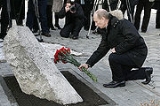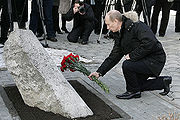
Novocherkassk Massacre
Encyclopedia
The Novocherkassk massacre or riots began on June 2, 1962 in the city Novocherkassk
, Soviet Union
(now Russia
).
By early 1960s, a dire economic situation had developed in the USSR By spring and the beginning of summer of 1962, the shortage of bread had become so evident, that Khruschev decided to start buying grain from abroad
The riots were a direct result of shortages of food and provisions, as well as the poor working conditions in the factory. The protest began on June 1 in the Budyonny
Electric Locomotive
Factory, when workers from the foundry
and forge
shops stopped work after factory management refused to hear their complaints. The strike and attendant discussions had spread throughout the whole factory by noon.
The unrest began when Nikita Khrushchev
doubled the prices of meat and butter on June 1, while increasing the minimum production quotas for each worker, thereby effectively reducing pay rates. This culminated in a march on the town hall and police headquarters, and the strike spread to other enterprises after police arrested thirty workers.
 Accounts of the government response are varied and often conflicting. There is some debate over who exactly fired on the demonstrators: the Soviet Army
Accounts of the government response are varied and often conflicting. There is some debate over who exactly fired on the demonstrators: the Soviet Army
or the KGB
. Some say that one army officer refused to order his men to fire on the protesters, and that KGB warning shots fired into the air hit children who had climbed into trees.
According to now available official sources, 22 protesters were killed by the machine-gun-equipped Soviet Army troops, and 87 were wounded. Three of the wounded later died. After the initial demonstrations, a curfew was implemented in the town. The dead bodies were secretly buried in the cemeteries of other towns of Rostov Oblast
. However, the following morning, a large group of several hundred demonstrators again gathered in the square. One hundred and sixteen were arrested, of which fourteen were tried by show trials, and seven of those received a death sentence. The others were sentenced to prison terms of ten to fifteen years.
Following the incident, the Soviet government directed extra food supplies to the region and began an investigation. Additional arrests of workers followed, as did courts martial of military officials involved. Aleksandr Solzhenitsyn
claimed that individuals wounded in the unrest and their families were exiled to Siberia
.
The whole story was never allowed to the press or any other Soviet mass media and remained classified until 1992, when the remains of 20 bodies were recovered and identified in 1992 on the cemetery of Novoshakhtinsk
.
Novocherkassk
Novocherkassk is a city in Rostov Oblast, Russia, located on the right bank of the Tuzlov River and on the Aksay River. Population: 169,039 ; 170,822 ; 178,000 ; 123,000 ; 81,000 ; 52,000 ....
, Soviet Union
Soviet Union
The Soviet Union , officially the Union of Soviet Socialist Republics , was a constitutionally socialist state that existed in Eurasia between 1922 and 1991....
(now Russia
Russia
Russia or , officially known as both Russia and the Russian Federation , is a country in northern Eurasia. It is a federal semi-presidential republic, comprising 83 federal subjects...
).
By early 1960s, a dire economic situation had developed in the USSR By spring and the beginning of summer of 1962, the shortage of bread had become so evident, that Khruschev decided to start buying grain from abroad
The riots were a direct result of shortages of food and provisions, as well as the poor working conditions in the factory. The protest began on June 1 in the Budyonny
Semyon Budyonny
Semyon Mikhailovich Budyonny , sometimes transliterated as Budennyj, Budyonnyy, Budennii, Budenny, Budyoni, Budyenny, or Budenny, was a Soviet cavalryman, military commander, politician and a close ally of Soviet leader Joseph Stalin.-Early life:...
Electric Locomotive
Locomotive
A locomotive is a railway vehicle that provides the motive power for a train. The word originates from the Latin loco – "from a place", ablative of locus, "place" + Medieval Latin motivus, "causing motion", and is a shortened form of the term locomotive engine, first used in the early 19th...
Factory, when workers from the foundry
Foundry
A foundry is a factory that produces metal castings. Metals are cast into shapes by melting them into a liquid, pouring the metal in a mold, and removing the mold material or casting after the metal has solidified as it cools. The most common metals processed are aluminum and cast iron...
and forge
Forge
A forge is a hearth used for forging. The term "forge" can also refer to the workplace of a smith or a blacksmith, although the term smithy is then more commonly used.The basic smithy contains a forge, also known as a hearth, for heating metals...
shops stopped work after factory management refused to hear their complaints. The strike and attendant discussions had spread throughout the whole factory by noon.
The unrest began when Nikita Khrushchev
Nikita Khrushchev
Nikita Sergeyevich Khrushchev led the Soviet Union during part of the Cold War. He served as First Secretary of the Communist Party of the Soviet Union from 1953 to 1964, and as Chairman of the Council of Ministers, or Premier, from 1958 to 1964...
doubled the prices of meat and butter on June 1, while increasing the minimum production quotas for each worker, thereby effectively reducing pay rates. This culminated in a march on the town hall and police headquarters, and the strike spread to other enterprises after police arrested thirty workers.

Soviet Army
The Soviet Army is the name given to the main part of the Armed Forces of the Soviet Union between 1946 and 1992. Previously, it had been known as the Red Army. Informally, Армия referred to all the MOD armed forces, except, in some cases, the Soviet Navy.This article covers the Soviet Ground...
or the KGB
KGB
The KGB was the commonly used acronym for the . It was the national security agency of the Soviet Union from 1954 until 1991, and was the premier internal security, intelligence, and secret police organization during that time.The State Security Agency of the Republic of Belarus currently uses the...
. Some say that one army officer refused to order his men to fire on the protesters, and that KGB warning shots fired into the air hit children who had climbed into trees.
According to now available official sources, 22 protesters were killed by the machine-gun-equipped Soviet Army troops, and 87 were wounded. Three of the wounded later died. After the initial demonstrations, a curfew was implemented in the town. The dead bodies were secretly buried in the cemeteries of other towns of Rostov Oblast
Rostov Oblast
Rostov Oblast is a federal subject of Russia , located in the Southern Federal District. Rostov Oblast has an area of and a population of making it the sixth most populous federal subject in Russia...
. However, the following morning, a large group of several hundred demonstrators again gathered in the square. One hundred and sixteen were arrested, of which fourteen were tried by show trials, and seven of those received a death sentence. The others were sentenced to prison terms of ten to fifteen years.
Following the incident, the Soviet government directed extra food supplies to the region and began an investigation. Additional arrests of workers followed, as did courts martial of military officials involved. Aleksandr Solzhenitsyn
Aleksandr Solzhenitsyn
Aleksandr Isayevich Solzhenitsyn was aRussian and Soviet novelist, dramatist, and historian. Through his often-suppressed writings, he helped to raise global awareness of the Gulag, the Soviet Union's forced labor camp system – particularly in The Gulag Archipelago and One Day in the Life of...
claimed that individuals wounded in the unrest and their families were exiled to Siberia
Siberia
Siberia is an extensive region constituting almost all of Northern Asia. Comprising the central and eastern portion of the Russian Federation, it was part of the Soviet Union from its beginning, as its predecessor states, the Tsardom of Russia and the Russian Empire, conquered it during the 16th...
.
The whole story was never allowed to the press or any other Soviet mass media and remained classified until 1992, when the remains of 20 bodies were recovered and identified in 1992 on the cemetery of Novoshakhtinsk
Novoshakhtinsk
Novoshakhtinsk is a mining city in Rostov Oblast, Russia, located on the border with Ukraine. Population:...
.
See also
- List of massacres in the Soviet Union
- Kengir uprisingKengir uprisingThe Kengir uprising was a prisoner uprising that took place in the Soviet prison labor camp Kengir in May and June 1954. Its duration and intensity distinguished it from other Gulag uprisings in the same period ....
- Vorkuta uprisingVorkuta UprisingThe Vorkuta Uprising was a major uprising of the concentration camp inmates at the Vorkuta Gulag in Vorkuta, Russia in July–August 1953, shortly after the arrest of Lavrentiy Beria. The uprising was violently stopped by the camp administration after two weeks of bloodless standoff.Vorkuta Rechlag ...

